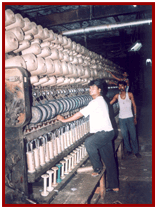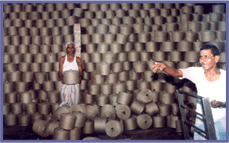|
|
|
Technology
|
|
|
Drawing :
Drawing is a process for reducing
sliver width and thickness by simultaneously mixing 4 to 6 sliver
together. There are three types of Drawing Frame machine. In most mills 3 Drawing passages are used in Hessian and 2 Drawing passages are used in
Sacking.
First Drawing :
The slivers obtained from finisher carding machine is fed with four slivers on
to the first drawing frame machine. The first drawing frame machines makes
blending, equalising the sliver and doubling two or more slivers, level and
provide quality and colour. This machines includes delivery roller,
pressing roller, retaining roller, faller screw sliders, check spring, back
spring, crimpling box etc..
Second Drawing :
In second drawing, the Second Drawing Frame machine obtain the sliver from
the First drawing machine and use six slivers and deliveries per
head. The Second Drawing machine makes more uniform sliver and
reduce the jute into a suitable size for third drawing.
|
|
|
|

|
Jute Processing Chart
|
|
|

|
Selection,
Softening & Piling, Carding
|
|
|

|
Drawing
& Doubling, Spinning, winding, Beaming/Dressing
|
|
|

|
Weaving,
Damping & Calendering, Lapping, Cutting
etc.
|
|
|

|
UNDP and Govt. of
India - National Jute
Development Program
|
|
|

|
Productivity
Improvement in Jute Industry - Report by I. I. T Kharagpur, 2000
|
|
|

|
Rice
Bran Oil (RBO) Technology - Food Grade Bags
|
|
Third Drawing :
In the third drawing, the Third Drawing frame machine uses the sliver from
second drawing. The Third Drawing machine is of high speed makes the
sliver more crimpled and suitable for spinning. The comparison of
the three drawing process:
|
Drawing Process |
Efficiency Range (%) |
Productivity Mt/mc/shift |
| Ist Drawing |
55 - 73 |
1.75 - 2.2 |
| IInd Drawing |
64 - 74 |
1.62 - 1.9 |
| IIIrd Drawing |
67 - 70 |
1.31 - 1.4 |
|
|
|
Spinning
:
Spinning is the process for
producing yarn from sliver obtained from Third drawing.
In the spinning process slivers are elongated and fibres are twisted into
yarn to impart strength. spun yarns in the spinning process are wound
onto Bobbins. after to fill the empty bobbins with yarn machine is
stopped, replace these bobbins by empty bobbins. The entire time is
called an average cycle time. The time for replacing the bobbins
full of yarn by empty bobbins is called softing time.
|

|
|
The jute spinning frame machine is fitted with slip draft zone and capable
of producing quality yarns at high efficiency with auto-dofting arrangements
also. A 4', pithch slip-draft sliver frames available of 20 spindles 100 spindles,
having a production range 8 uls to 28 uls with a flyer speed of 3200 to 4000
RPM. Spinning of several types of yarn is processed by spinning frame machine
usingdifferent kinds of bobbins, such as: Food Grade HCF, Sacking Wrap, Hessian Wrap,
Hessian Weft.
|
 |
Winding :
Winding is a process which
provides yarn as spools and cops for the requirement of beaming and weaving
operations. There are two types of winding :
(i) Spool
Winding
(ii) and Cope
Winding
|
|
(i) Spool Winding
In Spool Winding yarn is produces
for warp (the longitudinal yarn). Spool winding machine consists of a
number of spindles. There is wide variation in the number of spindles
per machines from one make to another. Productivity of spool winding
depends on the surface speed of the spindle and machine utilisation.
Spool winding machine uses the bobbins contain smaller length of yarn.
This machine wound the yarn into bigger packages known as 'spool'.
The Spool are used in making sheets of yarn to form warp portion used during
interleecment of weaving.
|
|
(ii) Cop Winding
Cop Winding machine obtain yarns from the spinning
machines. The spinning bobbins is placed on a suitable pin on top of
the cop machine and yarn tension is maintained by means of a small
leaver. The yarn on the bobbins are cnverted into hollow cylindrical
package said to be cop. The cop is used to form Transverse thread
during interlacement of weaving. Generally a cop winding machines
consist 120 spindles.
|
|
Beaming :
Beaming process is follows
after spool winding. In Beaming operation yarn from spool is wounded
over a beam of proper width and correct number of ends to weave jute
cloth. To increase the quality of woven cloth and weaving efficiency,
the wrap yarns are coated with starch paste. Adequate moisture is
essential in this process.
Quality characteristic of a beam is width of beam - number of ends and
weight of stand and there is a continuous passage of yarn through starch
solution from spools to the beam.
Strach solution in water contains tamerine kernel powder (TKP), antiseptic -
sodium silica fluride (NaSiF4)
and its concentration varies with the
quality of yarn.
|
|
|

|
Jute Composites
|

|
Advance Jute
Testing Equipment
|

|
Research in Jute
Related Fields
|
|
|
|
|
|
|
|
|
|
|
|
|
|
|
|
|
|
|
|
|
|
|
|
|
|
|
|
|
|
|
|
|
|
|
|
|
|
|
|
|
|
|
|
|
|
|
|
|
|

